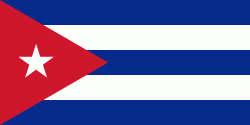La Habana Province (La Habana)
 |
The province's territory is the seat of the superior organs of the state and its provincial administration.
The Province of Havana was created in 1878, is one of the 6 original provinces in which the island was divided, still under Spanish colonial rule. In the political administrative division of 1976, in which the country was divided into 14 provinces, the first Province of Havana was divided into Havana City Province (capital) and Havana Province, with the areas surrounding the capital. The first of them integrated the territories of the metropolitan region of Havana, basically, the old municipalities of Havana, Marianao, Guanabacoa, Regla, Santiago de las Vegas and Santa María del Rosario as well as other adjoining areas.
On August 1, 2010, the National Assembly decided another modification of the territorial organization of Cuba, segmenting the then known as the Province of Havana, colloquially called "Habana Campo" in two new provinces, denominated Artemisa Province, to the west, and Mayabeque Province, to the east, which implied that, as of January 1, 2011 (date of the entry into force of said resolution), there would only be one Cuban province that would be called "from Havana", instead of two; reason why it was also agreed to change the denomination of "Province of Havana City" to that of "Province of Havana", without any need for further additions for, thus, to distinguish or individualize it. In addition, three municipalities of the Pinar del Río Province (Bahía Honda, Candelaria and San Cristóbal) were transferred to the new Province of Artemisa.
Between 1976 and 2010, the provincial administration of the then known as the Province of Havana had its headquarters in the territory of the Havana City Province, since it lacked capital of its own.
It was divided into two new provinces of Artemisa and Mayabeque on January 1, 2011.
Map - La Habana Province (La Habana)
Map
Country - Cuba
 |
 |
| Flag of Cuba | |
The territory that is now Cuba was inhabited by the Ciboney people from the 4th millennium BC with the Guanahatabey and Taíno peoples until Spanish colonization in the 15th century. From the 15th century, it was a colony of Spain, and slavery was abolished in 1886, remaining a Spanish colony until the Spanish–American War of 1898, when Cuba was occupied by the United States and gained independence in 1902. In 1940, Cuba implemented a new constitution, but mounting political unrest culminated in a coup in 1952 and the subsequent dictatorship of Fulgencio Batista, which was later overthrown in January 1959 by the 26th of July Movement during the Cuban Revolution, which afterwards established communist rule under the leadership of Fidel Castro. The country was a point of contention during the Cold War between the Soviet Union and the United States, and a nuclear war nearly broke out during the Cuban Missile Crisis of 1962. Following the collapse of the Soviet Union, Cuba faced a severe economic downturn in the 1990s, known as the Special Period. In 2008, Fidel Castro resigned after 49 years of leadership of Cuba and was replaced by his brother Raúl Castro.
Currency / Language
| ISO | Currency | Symbol | Significant figures |
|---|---|---|---|
| CUC | Cuban convertible peso | $ | 2 |
| CUP | Cuban peso | $ | 2 |
| ISO | Language |
|---|---|
| ES | Spanish language |

















